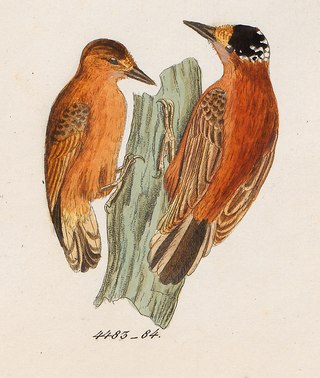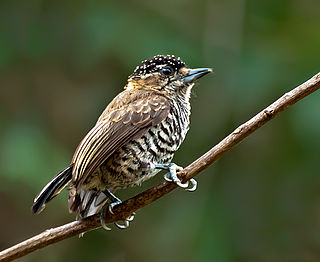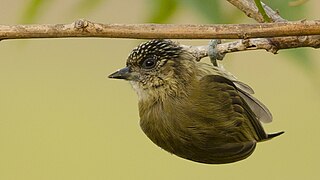
The white-wedged piculet is a species of bird in subfamily Picumninae of the woodpecker family Picidae. It is found in Argentina, Bolivia, Brazil and Paraguay.

The bar-breasted piculet is a species of bird in subfamily Picumninae of the woodpecker family Picidae. It is found in Bolivia, Brazil, Colombia, and Peru.

The plain-breasted piculet is a species of bird in subfamily Picumninae of the woodpecker family Picidae. It is found in the Brazil, Colombia, and Peru.

The chestnut piculet is a species of bird in subfamily Picumninae of the woodpecker family Picidae. It is found in Colombia and Venezuela.

The white-barred piculet is a species of bird in the woodpecker family Picidae. It is found in Argentina, Bolivia, Brazil, French Guiana, Guyana, Paraguay, and Uruguay.

The golden-spangled piculet is a species of bird in subfamily Picumninae of the woodpecker family Picidae. It is found in Brazil, Colombia, French Guiana, Guyana, Suriname, and Venezuela.

The greyish piculet is a species of bird in subfamily Picumninae of the woodpecker family Picidae. It is endemic to Colombia.

Lafresnaye's piculet is a species of bird in subfamily Picumninae of the woodpecker family Picidae. It is found in Brazil, Colombia, Ecuador, and Peru.

The ochraceous piculet is a species of bird in subfamily Picumninae of the woodpecker family Picidae. It is endemic to eastern Brazil.

The arrowhead piculet or Guianan piculet is a species of bird in subfamily Picumninae of the woodpecker family Picidae. It is found in Suriname and possibly French Guiana and Guyana.

The olivaceous piculet is a species of bird in subfamily Picumninae of the woodpecker family Picidae. It is found from Guatemala south through Central America and western South America to Peru.

The Orinoco piculet is a species of bird in subfamily Picumninae of the woodpecker family Picidae. It is found in Brazil, Colombia, and possibly Venezuela.

The spotted piculet is a species of bird in subfamily Picumninae of the woodpecker family Picidae. It is endemic to Brazil.

The rufous-breasted piculet is a species of bird in subfamily Picumninae of the woodpecker family Picidae. It is found in Bolivia, Brazil, Colombia, Ecuador, and Peru.

The white-bellied piculet is a Vulnerable species of bird in subfamily Picumninae of the woodpecker family Picidae. It is found in Brazil, Guyana, and Venezuela.

The scaled piculet is a species of bird in subfamily Picumninae of the woodpecker family Picidae. It is found in Colombia and Venezuela.

The fine-barred piculet is a species of bird in subfamily Picumninae of the woodpecker family Picidae. It is found in Brazil and Peru.

The ochre-collared piculet is a species of bird in subfamily Picumninae of the woodpecker family Picidae. It is found in Argentina, Brazil, and Paraguay.

The varzea piculet is a Near Threatened species of bird in subfamily Picumninae of the woodpecker family Picidae. It is endemic to Brazil's Amazon basin.

Picumnus is a large genus of piculets. With a total length of 8–10 cm (3–4 in), they are among the smallest birds in the woodpecker family. All species are found in the Neotropics except the speckled piculet that has a wide distribution in China, India and Southeast Asia.




















